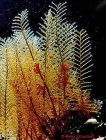WoRMS taxon details
Aglaopheniidae Marktanner-Turneretscher, 1890
1605 (urn:lsid:marinespecies.org:taxname:1605)
accepted
Family
- Genus Aglaophenia Lamouroux, 1812
- Genus Aglaophenopsis Fewkes, 1881
- Genus Carpocladus Vervoort & Watson, 2003
- Genus Cladocarpoides Bogle, 1984
- Genus Cladocarpus Allman, 1874
- Genus Gymnangium Hincks, 1874
- Genus Lytocarpia Kirchenpauer, 1872
- Genus Macrorhynchia Kirchenpauer, 1872
- Genus Monoserius Marktanner-Turneretscher, 1890
- Genus Nematocarpus Broch, 1918
- Genus Pachyrhynchia Kirchenpauer, 1872
- Genus Streptocaulus Allman, 1883
- Genus Taxella Allman, 1874
- Genus Wanglaophenia Vervoort & Watson, 2003
- Genus Acanthocladium Allman, 1883 accepted as Lytocarpia Kirchenpauer, 1872
- Genus Aglaophenoides Fraser, 1943 accepted as Aglaophenia Lamouroux, 1812 (synonym)
- Genus Aglophenia accepted as Aglaophenia Lamouroux, 1812 (misspelling)
- Genus Anisocalyx Costa, 1842 accepted as Aglaophenia Lamouroux, 1812 (synonym)
- Genus Cladocarpella Bale, 1915 accepted as Streptocaulus Allman, 1883
- Genus Dinotheca Stechow, 1911 accepted as Cladocarpus Allman, 1874 (synonym)
- Genus Diplocheilus Allman, 1883 accepted as Pycnotheca Stechow, 1919 (preoccupied by Diplocheilus van Hasselt, 1823 [Pisces])
- Genus Haliaria Stechow, 1921 accepted as Gymnangium Hincks, 1874 (synonym)
- Genus Halicetta Stechow, 1921 accepted as Gymnangium Hincks, 1874 (synonym)
- Genus Halicornaria Allman, 1874 accepted as Gymnangium Hincks, 1874 (invalid junior homonym of Halicornaria Hincks, 1865)
- Genus Lytocarpus Allman, 1883 accepted as Macrorhynchia Kirchenpauer, 1872 (synonym)
- Genus Makrorhynchia Kirchenpauer, 1872 accepted as Macrorhynchia Kirchenpauer, 1872 (unaccepted > misspelling - incorrect subsequent spelling)
- Genus Nematophorus Clarke, 1878 accepted as Macrorhynchia Kirchenpauer, 1872 (synonym)
- Genus Pleurocarpa Fewkes, 1881 accepted as Macrorhynchia Kirchenpauer, 1872 (synonym)
- Genus Thecocarpus Nutting, 1900 accepted as Lytocarpia Kirchenpauer, 1872 (unaccepted > junior objective synonym, synonym)
- Genus Theocarpus Nutting, 1900 accepted as Thecocarpus Nutting, 1900 accepted as Lytocarpia Kirchenpauer, 1872 (unaccepted > misspelling - incorrect subsequent spelling)
- Genus Tropidopathes Silberfeld, 1909 accepted as Gymnangium Hincks, 1874 (synonym)
marine, brackish, fresh, terrestrial
Marktanner-Turneretscher, G. 1890. Hydroiden des K. & K. Naturhistorischen Hofmuseums. - Annalen des K. K. Naturhistorischen Hofmuseums 5: 195-286., available online at https://www.biodiversitylibrary.org/page/4047029
page(s): 262 [details]
page(s): 262 [details]
Schuchert, P.; Choong, H.; Galea, H.; Hoeksema, B.; Lindsay, D.; Manko, M.; Pica, D. (2025). World Hydrozoa Database. Aglaopheniidae Marktanner-Turneretscher, 1890. Accessed through: World Register of Marine Species at: https://marinespecies.org/aphia.php?p=taxdetails&id=1605 on 2025-07-15
Date
action
by
2004-12-21 15:54:05Z
created
db_admin
![]() The webpage text is licensed under a Creative Commons
Attribution 4.0 License
The webpage text is licensed under a Creative Commons
Attribution 4.0 License
Nomenclature
original description
Marktanner-Turneretscher, G. 1890. Hydroiden des K. & K. Naturhistorischen Hofmuseums. - Annalen des K. K. Naturhistorischen Hofmuseums 5: 195-286., available online at https://www.biodiversitylibrary.org/page/4047029
page(s): 262 [details]
basis of record Bouillon, J.; Boero, F. (2000). Synopsis of the families and genera of the Hydromedusae of the world, with a list of the worldwide species. <i>Thalassia Salent. 24</i>: 47-296 (look up in IMIS) [details]
page(s): 262 [details]
basis of record Bouillon, J.; Boero, F. (2000). Synopsis of the families and genera of the Hydromedusae of the world, with a list of the worldwide species. <i>Thalassia Salent. 24</i>: 47-296 (look up in IMIS) [details]
Other
 Present
Present  Inaccurate
Inaccurate  Introduced: alien
Introduced: alien  Containing type locality
Containing type locality
From editor or global species database
Diagnosis Colony forming upright pinnate shoots, mono- or polysiphonic, branched or unbranched, arising from creeping hydrorhiza or from anchoring filaments; hydrocladia alternate or opposite in one plane, or arranged spirally; hydrothecae uniseriate, usually completely adnate, with or without marginal cusps, with or without intrathecal septum, absent from hydrocaulus except in basalmost segment; nematophores with nematothecae, not as naked sarcostyles; nematothecae at least partially fused to hydrothecae, one-chambered (monothalamic) and immovable; hydrotheca typically flanked with one pair of lateral nematothecae, and with an unpaired median inferior nematotheca that may be doubled or have two terminal apertures; sometimes also a pair of superior nematothecae; gonothecae lacking nematothecae, unprotected, or surrounded by curved branches in phylactocarp, or nearly completely enclosed within corbulae; fixed sporosacs or swimming gonophores. [details]
| Language | Name | |
|---|---|---|
| Japanese | アカガヤ科 | [details] |










